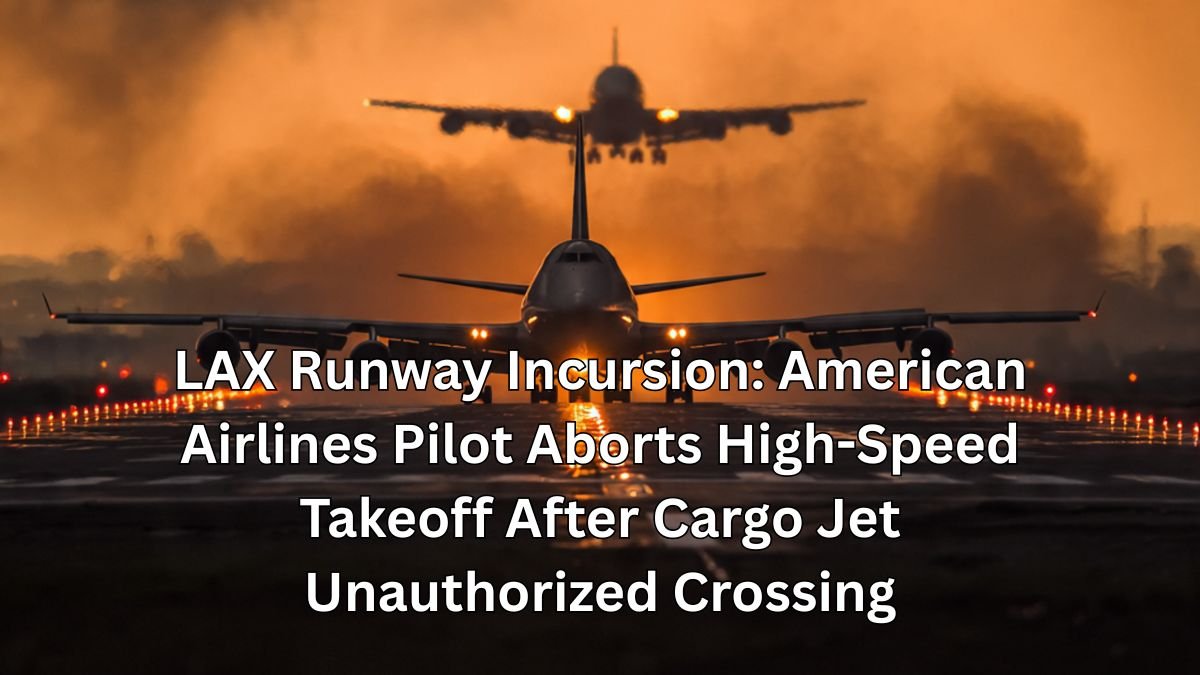LOS ANGELES, CA – The Federal Aviation Administration (FAA) has launched an investigation into a serious runway safety breach at Los Angeles International Airport (LAX) on Sunday night. An American Airlines passenger jet, cleared for takeoff, was forced to execute a high-speed emergency stop after a massive cargo plane unexpectedly taxied across the active runway directly in its path.
The incident highlights growing concerns about runway safety events, often called “runway incursions,” at major US airports.
The Close Call Unfolds
The near-miss occurred around 10:35 p.m. local time. American Airlines Flight 2453, an Airbus A321 bound for Boston’s Logan International Airport, was accelerating rapidly down the runway after receiving takeoff clearance from the air traffic control tower.
Simultaneously, AeroLogic Flight 619, a Boeing 777 freighter (cargo jet) arriving from Shanghai, was taxiing toward its gate. The FAA reported that the AeroLogic crew crossed Runway 25R “without authorization,” directly into the path of the accelerating passenger plane.
Emergency Stop at High Speed
Air traffic control immediately recognized the severe danger and urgently instructed the American Airlines pilot to “cancel takeoff clearance.”
Audio recordings from LiveATC.net captured the dramatic exchange, including the urgent command from the controller and the response from the cargo pilot confirming they were on the runway.
The American Airlines crew responded instantly, slamming on the brakes in a critical high-speed maneuver known as a rejected takeoff. According to flight tracking data, the passenger jet was accelerating at approximately 167 miles per hour (145 knots) when the pilots reacted.
At their closest point, the two large aircraft were separated by only about 1.3 miles (5,200 feet). Experts noted that the situation was fortunate due to LAX’s unusually long runway, which provided sufficient stopping distance for the American Airlines jet.
Investigation Points to Pilot Error
While the FAA is probing the official cause, preliminary reports suggest a potential deviation by the cargo flight crew. Air traffic control had reportedly directed the AeroLogic flight to cross a different runway (Runway 25L) to reach the cargo area. However, the pilots of the Boeing 777 mistakenly made a right turn, placing them onto the runway where the American Airlines jet was taking off.
The entire maneuver, a high-speed rejected takeoff, put immense strain on the brakes and landing gear of the American Airlines A321, which had to be inspected for damage before being cleared to fly again.
The Aftermath
No injuries were reported among the passengers or crew of either aircraft.
American Airlines issued a statement thanking their crew members for their “quick action” and their customers for their patience. The flight returned to the gate and was eventually able to depart for Boston approximately two and a half hours later, using the same aircraft after a thorough inspection confirmed no damage.
The incident is the latest in a series of close calls at US airports that have prompted the FAA and the National Transportation Safety Board (NTSB) to renew their focus on reducing the frequency of such dangerous runway incursions.
Conclusion
Sunday night’s near-catastrophe at LAX serves as a chilling reminder of the fine margin for error in commercial aviation. The immediate, decisive action by the American Airlines flight crew and the air traffic controller averted what could have been a major disaster. While the flight arrived late, the event underscores the necessity of strict adherence to air traffic control instructions and the need for constant vigilance, especially at busy, complex airport hubs like LAX. The FAA’s ongoing investigation will be crucial in determining exactly how the breakdown in communication or procedure occurred.
Affiliate Disclosure
This article does not contain affiliate links. We do not receive compensation for any links provided.
Disclaimer
This report is based on information provided by the Federal Aviation Administration (FAA), American Airlines, and flight tracking data (Flightradar24). The details are subject to change as the official FAA investigation progresses. Always check the official website of the Federal Aviation Administration (https://www.faa.gov/) for the latest safety and investigation updates, and the official website of American Airlines (https://www.aa.com/) for flight status information.







